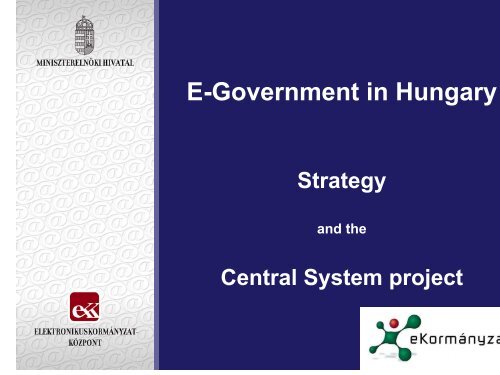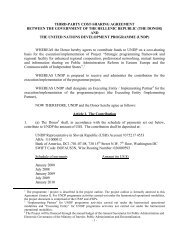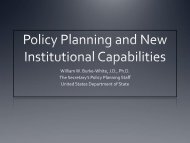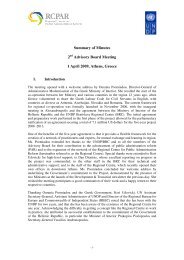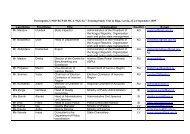E-Government in Hungary
E-government in Hungary - Rcpar.org
E-government in Hungary - Rcpar.org
You also want an ePaper? Increase the reach of your titles
YUMPU automatically turns print PDFs into web optimized ePapers that Google loves.
E-<strong>Government</strong> <strong>in</strong> <strong>Hungary</strong><br />
Strategy<br />
and the<br />
Central System project
The pr<strong>in</strong>cipal objective of e-Governance <strong>in</strong> 2005 was to develo<br />
a higher quality and more efficient governance us<strong>in</strong>g modern<br />
<strong>in</strong>fo-communication technologies<br />
On-l<strong>in</strong>e<br />
Efficient<br />
Knowledgebased<br />
Client-oriented Social Democratic<br />
EU<br />
compatib<br />
• The e-<strong>Government</strong> Strategy is a set of transparent political objectives and also a straightforward<br />
implementation plan, supported by the <strong>Government</strong>’s commitment to reform<strong>in</strong>g the public<br />
adm<strong>in</strong>istration system and creat<strong>in</strong>g a client-focused state that provides services to its citizens.<br />
• The objectives aim to develop seven govern<strong>in</strong>g skills essential for the new type of governance.<br />
• Due to their novelty these abilities represent a great challenge to all organisations of the<br />
Hungarian public adm<strong>in</strong>istration. Their implementation requires considerable commitment to<br />
<strong>in</strong>novation on the <strong>Government</strong>’s part, and they may result <strong>in</strong> a more efficient national governance<br />
<strong>in</strong> harmony with the pan-European services of the EU.
The implementation of the strategy affects all fields of<br />
government operations and triggers a comprehensive<br />
transition <strong>in</strong> governance<br />
• In accordance with the objectives of the e-<br />
<strong>Government</strong> Strategy, the EKK encourages<br />
and coord<strong>in</strong>ates the development of<br />
<strong>in</strong>dividual IT strategies for the various<br />
<strong>in</strong>stitutions, and prepares standards and<br />
recommendations to support <strong>in</strong>stitutional<br />
developments.<br />
• At the same time, the <strong>in</strong>stitutions themselves<br />
are primarily responsible for creat<strong>in</strong>g their<br />
own official procedures and services.<br />
• The implementation of the strategy results <strong>in</strong><br />
significant changes <strong>in</strong> a number of areas of<br />
governance from regulation to <strong>in</strong>frastructural<br />
elements to cooperation with<strong>in</strong> the<br />
<strong>in</strong>stitutional framework.<br />
Regulation and<br />
procedures<br />
Info-communication<br />
<strong>in</strong>frastructure<br />
Content and services<br />
Culture and <strong>in</strong>dividual<br />
knowledge<br />
Institutional framework<br />
and cooperation
The implementation of the strategy has commenced <strong>in</strong> six<br />
framework programs<br />
FIELDS<br />
Regulation and<br />
procedures<br />
Info-communication<br />
<strong>in</strong>frastructure<br />
Content and<br />
services<br />
Culture and<br />
<strong>in</strong>dividual<br />
knowledge<br />
Institutional<br />
framework and<br />
cooperation<br />
E-GOVERNING ABILITIES<br />
On-l<strong>in</strong>e Efficient Knowledge-basedClient-oriented Social Democratic<br />
e-Regulation<br />
Basic e-Infrastructure<br />
e-Efficiency<br />
e-Service<br />
e-Culture<br />
EU<br />
compatible<br />
EU Integration<br />
• All framework programs of the e-Governance Strategy aim to develop the governance competencies<br />
that are required for a state to provide services and to facilitate onl<strong>in</strong>e operation. The key objective of the<br />
strategy is to manage the governance transition process that will create the framework for modern<br />
governance through e-government services.
The first priority program of the e-Governance Strategy aims to<br />
create the <strong>in</strong>frastructural basis of onl<strong>in</strong>e governance <strong>in</strong> Hunga<br />
Justification<br />
• When the e-Governance Strategy was<br />
developed, there was no countrywide<br />
broadband telecommunication network<br />
facilitat<strong>in</strong>g government agencies to<br />
communicate securely on the <strong>in</strong>ternet.<br />
• The isolated development efforts of the various<br />
government agencies would not have resulted<br />
<strong>in</strong> a consistent basic <strong>in</strong>frastructure suitable for<br />
e-governance.<br />
Objective<br />
• The objective of the Basic e-Infrastructure is to<br />
provide the conditions and the environment for<br />
electronic operation of onl<strong>in</strong>e governance <strong>in</strong><br />
<strong>Hungary</strong>, to create a consistent telematic<br />
government network as part of the Central<br />
System (KR) and a central basic <strong>in</strong>frastructure<br />
facilitat<strong>in</strong>g the use of e-governance <strong>in</strong>formation<br />
and transaction services.<br />
Info-communication<br />
<strong>in</strong>frastructure<br />
Content and services<br />
Culture and <strong>in</strong>dividual<br />
knowledge<br />
Institutional framework<br />
and cooperation<br />
Onl<strong>in</strong>e<br />
Basic e-Infrastructure
The elements of the Central System: the EKG, the Client<br />
Gateway, the Client Hotl<strong>in</strong>e and the <strong>Government</strong> Portal were<br />
completed by early 2006, and thus the technical framework of<br />
onl<strong>in</strong>e governance was <strong>in</strong> place<br />
Results<br />
• The EKG (Hungarian <strong>Government</strong> Backbone<br />
Network), the <strong>Government</strong> Portal, the Client<br />
Gateway and the Client Hotl<strong>in</strong>e form<strong>in</strong>g part<br />
of the Central System were completed<br />
• The EKG is the most secure government<br />
network <strong>in</strong> the region<br />
• In 2006 all government agencies will be<br />
connected<br />
• It connects to TESTA and H-Sec-Net<br />
• It provides basic and premium services<br />
• The <strong>Government</strong> Portal and the Client<br />
Gateway provide access to standard<br />
government onl<strong>in</strong>e <strong>in</strong>formation and<br />
transactional services<br />
• The Client Hotl<strong>in</strong>e (189) makes process<br />
descriptions available by phone, ensur<strong>in</strong>g<br />
equal opportunities<br />
• Regulation issues concern<strong>in</strong>g the<br />
implementation of e-payment and e-signature<br />
to produce fully onl<strong>in</strong>e adm<strong>in</strong>istrative<br />
procedures have been resolved<br />
Development of the Hungarian <strong>Government</strong><br />
Backbone Network (HGBN)<br />
• Increased number of EKG end po<strong>in</strong>ts<br />
• Security, <strong>in</strong>ternet protection system<br />
Standard government onl<strong>in</strong>e and electronic<br />
<strong>in</strong>formation service<br />
• <strong>Government</strong> Portal (www.magyarorszag.hu)<br />
• Standardisation of central public adm<strong>in</strong>istration<br />
portals<br />
• Client Hotl<strong>in</strong>e<br />
Standard government onl<strong>in</strong>e transaction<br />
services<br />
• Client Gateway<br />
• E-signature<br />
• E-payment
One of the most important tasks <strong>in</strong> 2006 will be to expand the<br />
service portfolio <strong>in</strong> l<strong>in</strong>e with the EU’s pan-European services,<br />
and to <strong>in</strong>crease the relative weight of fully onl<strong>in</strong>e services.<br />
Future tasks<br />
• One of the most important tasks <strong>in</strong> 2006<br />
will be to develop efficient cooperation<br />
between government agencies so that<br />
the government portal can offer high<br />
quality contents;<br />
Portal<br />
HGBN<br />
Central<br />
System<br />
(KR)<br />
Client Gateway<br />
• A comprehensive payment service will<br />
have to be added to the exist<strong>in</strong>g central<br />
<strong>in</strong>frastructure to ensure that the Central<br />
System will be able to meet the highest<br />
electronic service level.<br />
Client Hotl<strong>in</strong>e<br />
E-payment
The Central System and the Transport Eng<strong>in</strong>e<br />
Control and Coord<strong>in</strong>ation<br />
Interface<br />
Security,<br />
Payment<br />
Construction <strong>in</strong>itiatives<br />
for Portal, best<br />
practice, etc.<br />
Magyarorszag.hu<br />
<strong>Government</strong>al Portal,<br />
Information Centre<br />
Authentication, Payment<br />
e- and m-<br />
Gov’tal Portal<br />
Citizen’s Gateway<br />
Institutional provider system 1<br />
Institutional provider system 2<br />
Gov’t to Client<br />
Information Centre<br />
G2C, G2B, G2G<br />
systems and<br />
applications<br />
Central <strong>Government</strong>al Service<br />
Provider System,<br />
Central Databases,<br />
Address Register,<br />
Mail<strong>in</strong>g System<br />
Institutional provider system ..n<br />
Local Gov’t Provider Serv. System ..1<br />
Local Gov’t Provider Serv. System..n<br />
Bus<strong>in</strong>ess Service Provider System 1<br />
Bus<strong>in</strong>ess Service Provider System ..n<br />
Basic<br />
<strong>in</strong>frastructure<br />
<strong>Government</strong> Backbone Network<br />
(HGBN), Internet access<br />
HGBN
The simultaneous use of electronic and traditional services<br />
doubles adm<strong>in</strong>istrative costs, thus it is particularly important<br />
that onl<strong>in</strong>e governance be extended as fully as possible<br />
across all operations<br />
Future tasks<br />
• The first step towards onl<strong>in</strong>e governance is to<br />
have all <strong>in</strong>stitutions develop their <strong>in</strong>ternal e-<br />
operations compris<strong>in</strong>g the follow<strong>in</strong>g elements:<br />
• Intranet<br />
• Web presence<br />
• Public servant card<br />
• Process descriptions<br />
• Electronic records<br />
• Electronic rules of procedures<br />
• The next step is to ensure that the various<br />
<strong>in</strong>stitutions provide their onl<strong>in</strong>e services<br />
through the Central System (KR).<br />
• Institutional systems can be connected to the<br />
KR at four levels:<br />
• Level 1: Connection to the HGBN us<strong>in</strong>g basic<br />
services<br />
• Level 2: Connection to the HGBN us<strong>in</strong>g premium<br />
services<br />
• Level 3: Connection to the government portal<br />
through the electronic <strong>in</strong>formation system of the<br />
relevant <strong>in</strong>stitution<br />
• Level 4: Connection to the Client Gateway<br />
through the electronic service system of the<br />
<strong>in</strong>stitution<br />
CG<br />
L<strong>in</strong>k to<br />
government<br />
portal<br />
L<strong>in</strong>k to the HGBN<br />
us<strong>in</strong>g premium<br />
services<br />
L<strong>in</strong>k to the HGBN<br />
Us<strong>in</strong>g basic services
Content
The success of the new type of client-focused public<br />
adm<strong>in</strong>istration depends on the ability of the <strong>in</strong>stitutional<br />
framework to provide services built on the citizens’<br />
requirements<br />
Future tasks<br />
Level 1<br />
• The number one priority of the com<strong>in</strong>g period is<br />
to further modernise the 20 services required<br />
by the EU, and to develop fully electronic<br />
adm<strong>in</strong>istrative procedures.<br />
Level 2<br />
• One of the most important tasks for the com<strong>in</strong>g<br />
years is to expand the service portfolio <strong>in</strong> l<strong>in</strong>e<br />
with the EU’s pan-European services.<br />
Level 3<br />
• The success of onl<strong>in</strong>e governance depends on<br />
the extent to which citizens wish to take<br />
advantage of the possibility of electronic<br />
adm<strong>in</strong>istration, thus it is particularly important<br />
that, <strong>in</strong> addition to traditional adm<strong>in</strong>istration, a<br />
client-friendly service portfolio is developed <strong>in</strong><br />
response to clients’ needs.<br />
Onl<strong>in</strong>e operations<br />
Level 3<br />
Level 2<br />
Level 1<br />
Number of services
The EU accession has been a big challenge for the<br />
<strong>in</strong>stitutional framework; comply<strong>in</strong>g with the obligations and<br />
exploit<strong>in</strong>g the benefits require a lot of <strong>in</strong>puts<br />
Justification<br />
• The tasks aris<strong>in</strong>g from the EU accession <strong>in</strong>volv<strong>in</strong>g<br />
build<strong>in</strong>g cooperation at central and <strong>in</strong>stitutional<br />
level have represented a great challenge to the<br />
<strong>in</strong>stitutional framework. Exploit<strong>in</strong>g the benefits<br />
orig<strong>in</strong>at<strong>in</strong>g from our full EU membership, tak<strong>in</strong>g<br />
advantage of the knowledge base and the<br />
f<strong>in</strong>ancial resources and their <strong>in</strong>tegration <strong>in</strong>to<br />
Hungarian developments have been similarly<br />
important.<br />
Objective<br />
• The objective of the program is to prepare the<br />
Hungarian <strong>in</strong>stitutional framework to jo<strong>in</strong> those of<br />
the EU and subsequently to improve<br />
<strong>in</strong>frastructural and <strong>in</strong>stitutional cooperation.<br />
• The program has to ensure that the Hungarian<br />
<strong>in</strong>stitutional framework is connected to the EU<br />
networks and that <strong>in</strong>stitutions are <strong>in</strong>volved <strong>in</strong> the<br />
e-governance programs of the EU at both central<br />
and sectoral levels.<br />
Regulation and<br />
procedures<br />
Info-communication<br />
<strong>in</strong>frastructure<br />
Content and services<br />
Culture and<br />
<strong>in</strong>dividual knowledge<br />
Institutional framework<br />
and cooperation<br />
EU<br />
compatible<br />
EU Integration
The central electronic government has been successfully<br />
connected to the <strong>in</strong>frastructural systems of the EU and<br />
cooperation between <strong>in</strong>stitutional frameworks has expanded<br />
Results<br />
• The Hungarian <strong>in</strong>stitutional framework was<br />
among the first to be connected to TESTA<br />
through the EKG (H-Sec-Net was launched)<br />
• The EKK and the IHM are <strong>in</strong>volved <strong>in</strong> the<br />
creative work associated with the EU i2010<br />
strategy<br />
• The EKK is participat<strong>in</strong>g <strong>in</strong> the management of<br />
the IDABC program launched to realise pan-<br />
European e-government services<br />
• Hungarian <strong>in</strong>stitutions are participat<strong>in</strong>g <strong>in</strong> the<br />
sectoral programs of the IDABC, coord<strong>in</strong>ated by<br />
the IDASZB Committee<br />
• Developments underway make use of EU<br />
knowledge bases and its free software (eL<strong>in</strong>k,<br />
CIRCA, IPM)<br />
• From the EU funds<br />
• pre-accession funds were used by the central<br />
<strong>in</strong>stitutions, and<br />
• NFT (National Development Plan) funds were used<br />
by local governments.<br />
• The government has not yet been able to take<br />
advantage of the possibilities offered by<br />
Community programs<br />
Infrastructural developments<br />
• H-SEC-NET<br />
• TESTA<br />
Cooperation between <strong>in</strong>stitutional frameworks<br />
• Program management<br />
• Horizontal areas<br />
• CIRCA<br />
• IPM<br />
• eL<strong>in</strong>k<br />
Knowledge management<br />
Explor<strong>in</strong>g EU development funds<br />
• Pre-accession funds<br />
• Hungarian NDP<br />
• Community Programs
By the end of the decade the EU plans to develop a pan-<br />
European services system connect<strong>in</strong>g all Member States,<br />
which will provide a full range of tools for national<br />
governments to communicate with one another<br />
Future tasks<br />
• The EU <strong>in</strong>tegration is an important framework<br />
program of the strategy, but it is also a<br />
significant driv<strong>in</strong>g force beh<strong>in</strong>d the<br />
development of onl<strong>in</strong>e services <strong>in</strong> <strong>Hungary</strong>;<br />
• Accord<strong>in</strong>g to the plans for European<br />
Interoperability, all EU citizens will enter the<br />
standard EU service platform through a<br />
shared European Client Gateway;<br />
• At the same time, it is important that <strong>in</strong> the<br />
future years, while the development of onl<strong>in</strong>e<br />
services <strong>in</strong> <strong>Hungary</strong> enables us to become an<br />
active and <strong>in</strong>creas<strong>in</strong>gly <strong>in</strong>volved participant of<br />
the evolv<strong>in</strong>g EU e-governance framework<br />
system, we also learn how to secure external<br />
fund<strong>in</strong>g to complement the NDP programs<br />
from programs support<strong>in</strong>g the implementation<br />
of Community Policies for the realisation of<br />
Hungarian e-governance developments.<br />
Member State A<br />
Public<br />
adm<strong>in</strong>istration<br />
Member State B<br />
Public<br />
adm<strong>in</strong>istration<br />
EU public adm<strong>in</strong>istration<br />
EU Citizen
EXTENDING THE STRATEGIC PROGRAMS TO THE<br />
ENTIRE INSTITUTIONAL FRAMEWORK
Once the central systems and the basic regulation are <strong>in</strong> place<br />
the pr<strong>in</strong>cipal task of e-government is to extend onl<strong>in</strong>e<br />
governance to the entire <strong>in</strong>stitutional framework<br />
• The basic <strong>in</strong>frastructure of e-<br />
governance has been created <strong>in</strong> the<br />
past three years, <strong>in</strong>itiated and<br />
coord<strong>in</strong>ated by the EKK;<br />
service<br />
• The challenge for the com<strong>in</strong>g years is to<br />
extend the program to the entire<br />
<strong>in</strong>stitutional framework of the<br />
government;<br />
IT<br />
<strong>in</strong>frastructure<br />
Regulation<br />
• The various <strong>in</strong>stitutions also need to<br />
prepare their own e-governance<br />
strategies and plans specify<strong>in</strong>g:<br />
• the scope and contents,<br />
• the required regulation,<br />
• the <strong>in</strong>formation technology background<br />
• the <strong>in</strong>dividual and organisational<br />
knowledge management and<br />
• the required EU cooperation<br />
of the e-services to be developed.<br />
Culture and<br />
knowledge<br />
Central<br />
coord<strong>in</strong>ation<br />
Efficiency<br />
EU<br />
cooperation
The program extended to the entire <strong>in</strong>stitutional framework<br />
needs to be centrally coord<strong>in</strong>ated to ensure that the transition<br />
takes place with uniform standards and that resources are used<br />
efficiently<br />
• In most EU Member States the extension of<br />
e-governance to the entire public<br />
adm<strong>in</strong>istration is a high-priority central<br />
government task.<br />
• To ensure the efficient use of resources,<br />
generally a central coord<strong>in</strong>at<strong>in</strong>g body is set<br />
up to manage the above process, which is<br />
responsible for a number of tasks, such as:<br />
• standards development<br />
• resource management<br />
• knowledge management<br />
• <strong>in</strong>stitutional coord<strong>in</strong>ation.<br />
• The first step of extend<strong>in</strong>g the e-government<br />
strategy is to determ<strong>in</strong>e the tasks and<br />
authority of a central coord<strong>in</strong>at<strong>in</strong>g body <strong>in</strong><br />
<strong>Hungary</strong>.<br />
Development of uniform standards<br />
Resource management<br />
Connection to the central systems<br />
Knowledge management<br />
Coord<strong>in</strong>ation of cooperation with<strong>in</strong><br />
the <strong>in</strong>stitutional framework
It is essential to determ<strong>in</strong>e and legally establish the scope<br />
and rules of cooperation accord<strong>in</strong>g to which the central<br />
coord<strong>in</strong>at<strong>in</strong>g body can lead the next steps <strong>in</strong> the transition of<br />
the <strong>in</strong>stitutional framework<br />
• The <strong>in</strong>stitutional framework and the central<br />
coord<strong>in</strong>at<strong>in</strong>g body can cooperate successfully<br />
<strong>in</strong> a number of ways;<br />
Develop the <strong>in</strong>stitutional cooperation<br />
model, ”enterprise architecture”<br />
• It is worth look<strong>in</strong>g at examples provided by the<br />
relevant EU Member States, but the operation<br />
model essentially needs to be developed<br />
based on the conditions and characteristics of<br />
public adm<strong>in</strong>istration <strong>in</strong> <strong>Hungary</strong>;<br />
• The model needs to clarify, among others, the<br />
follow<strong>in</strong>g:<br />
• roles and responsibilities;<br />
• task allocation and<br />
• motivation.<br />
Develop the required regulation<br />
Determ<strong>in</strong>e roles and responsibilities<br />
Allocate tasks<br />
Create motivation
In addition to creat<strong>in</strong>g and regulat<strong>in</strong>g a central coord<strong>in</strong>ation<br />
model, it is also very important to identify and correctly allocat<br />
the resources available<br />
• The EKK has achieved significant results<br />
us<strong>in</strong>g the funds allocated to the<br />
implementation of the framework programs of<br />
the e-<strong>Government</strong> Strategy: it has created a<br />
central <strong>in</strong>frastructure for e-governance.<br />
• In the past three years, <strong>in</strong> addition to the EKK<br />
coord<strong>in</strong>ation, over HUF 140 billion has been<br />
spent on <strong>in</strong>dividual governmental <strong>in</strong>formation<br />
technology developments. Another HUF 120<br />
billion has been spent on developments<br />
related to the <strong>in</strong>formation society.<br />
• In the field of e-governance coord<strong>in</strong>ated<br />
developments are more efficient than<br />
significant <strong>in</strong>vestment projects us<strong>in</strong>g<br />
fragmented sources of funds.<br />
• The range of fund<strong>in</strong>g options must be explored<br />
and funds must be used efficiently, <strong>in</strong><br />
accordance with a plan based on central<br />
coord<strong>in</strong>ation<br />
NDP II.<br />
E-government developments<br />
Sectoral and <strong>in</strong>dividual <strong>in</strong>formation<br />
technology developments<br />
Central <strong>in</strong>formation technology<br />
developments<br />
Direct Community resources<br />
PPP type cooperations
Thank you for your<br />
attention!<br />
Gábor BÓDI<br />
Head of Department, <strong>Government</strong> Advisor<br />
Prime M<strong>in</strong>ister’s Office<br />
Electronic <strong>Government</strong> Centre


